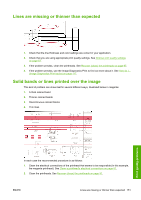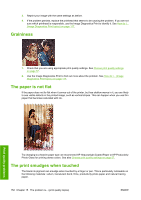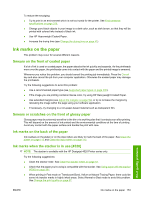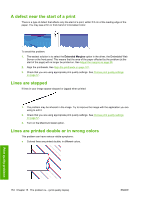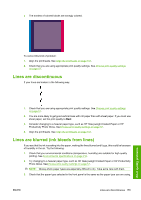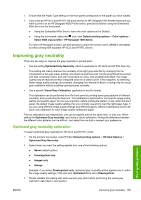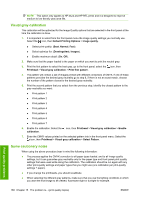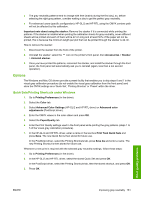HP Color LaserJet Enterprise CP4020 HP Designjet 4020 and 4520 Printer Series - Page 166
Lines are slightly warped, Color accuracy
 |
View all HP Color LaserJet Enterprise CP4020 manuals
Add to My Manuals
Save this manual to your list of manuals |
Page 166 highlights
4. Perhaps you have adjusted the drying time at the front panel to speed up the printer output. Select the icon, then Select drying time, and make sure it is set to Optimal. 5. Allow the prints time to dry separately; do not cover or stack them. Lines are slightly warped The paper itself may be warped. This can happen if it has been used or stored in an extreme environment. See Environmental specifications on page 210. Color accuracy There are two basic requirements for color accuracy: 1. Ensure that your paper type has been calibrated, which will give you consistency from print to print, and from printer to printer. See Perform color calibration on page 68. 2. Select suitable options in your application: see How do I... (color topics) on page 67. NOTE: If you are not using PostScript, remember that your printer may be configured to use one of its internal pen palettes instead of your software's palette (which is the default). See Pen settings seem to have no effect on page 165. Color accuracy using EPS or PDF images in page layout applications Page layout applications such as Adobe InDesign and QuarkXPress do not support color management of EPS, PDF or grayscale files. If you have to use such files, try to ensure that the EPS, PDF or grayscale images are already in the same color space that you intend to use later on in Adobe InDesign or QuarkXPress. For instance, if your final goal is to print the job in a press that follows the SWOP standard, at the time of creating the EPS, PDF or grayscale you should convert the image into SWOP. PANTONE color accuracy Spot colors are special premixed inks to be used directly in the press, and the best-known spot colors are PANTONE colors. If you have the PostScript model, your printer provides a facility called Automatic PANTONE Calibration, which can easily match most of the PANTONE Solid Coated spot colors. When an application sends a PANTONE color to print, it sends the PANTONE name together with its own estimate of equivalent CMYK values. The Automatic PANTONE Calibration facility recognizes the PANTONE name and converts it to CMYK in a way that depends on the printer model and the selected paper type, enabling the color to be rendered with greater precision than is possible with the generic CMYK values sent by the application. Even when using Automatic PANTONE Calibration, you cannot expect the printer to match the PANTONE colors exactly. Your printer is certified by Pantone for some papers, but this does not mean that it can reproduce 100% of the PANTONE colors. Using Automatic PANTONE Calibration (the best choice) In order to use Automatic PANTONE Calibration, you need an application that recognizes the PANTONE colors, and a calibrated PostScript printer. The Automatic PANTONE Calibration facility emulates PANTONE Solid Coated colors only (suffix C). Other PANTONE colors will be printed using the CMYK values sent by the application. Print quality problems 156 Chapter 15 The problem is... (print quality topics) ENWW



